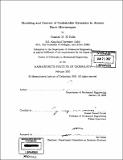Modeling and control of undesirable dynamics in atomic force microscopes
Author(s)
El Rifai, Osamah M
DownloadFull printable version (39.37Mb)
Other Contributors
Massachusetts Institute of Technology. Dept. of Mechanical Engineering.
Advisor
Kamal Youcef-Toumi.
Terms of use
Metadata
Show full item recordAbstract
The phenomenal resolution and versatility of the atomic force microscope (AFM), has made it a widely-used instrument in nanotechnology. In this thesis, a detailed model of AFM dynamics has been developed. It includes a new model for the piezoelectric scanner coupled longitudinal and lateral dynamics, creep, and hysteresis. Models for probe-sample interactions and cantilever dynamics were also included. The models were used to improve the dynamic response and hence image quality of contact-mode AFM. An extensive parametric study has been performed to experimentally analyze in-contact dynamics. Nonlinear variations in the frequency response were observed, in addition to changes in the pole-zero structure. The choice of scan parameters was found to have a major impact on image quality and feedback performance. Further, compensation for scanner creep was experimentally tested yielding a reduction in creep by a factor of 3 to 4 from the uncompensated system. Moreover, fundamental performance limitations in the AFM feedback system were identified. These limitations resulted in a severe bound on the maximum achievable feedback bandwidth, as well as a fundamental trade-off between step response overshoot and response time. A careful analysis has revealed that a PID controller has no real advantage over an integral controller. (cont.) Therefore, a procedure for automatically selecting key scan parameters and controller gain was developed and experimentally tested for I-control. This approach, in contrast to the commonly used trial and error method, can substantially improve image quality and fidelity. In addition, a robust adaptive output controller (RAOC), was designed to guarantee global boundedness and asymptotic regulation in the presence and absence of disturbances, respectively. Simulations have shown that a substantial reduction in contact force can be achieved with the RAOC, in comparison with a well-tuned I-controller, yet with no increase in the maximum scan speed. Furthermore, a new method was developed to allow calibrating the scanner's vertical displacement up to its full range, in addition to characterizing scanner hysteresis. This work has identified and addressed crucial problems and proposed practical solutions to factors limiting the dynamic performance of the AFM.
Description
Thesis (Ph. D.)--Massachusetts Institute of Technology, Dept. of Mechanical Engineering, 2002. Includes bibliographical references (leaves 156-165).
Date issued
2002Department
Massachusetts Institute of Technology. Department of Mechanical EngineeringPublisher
Massachusetts Institute of Technology
Keywords
Mechanical Engineering.